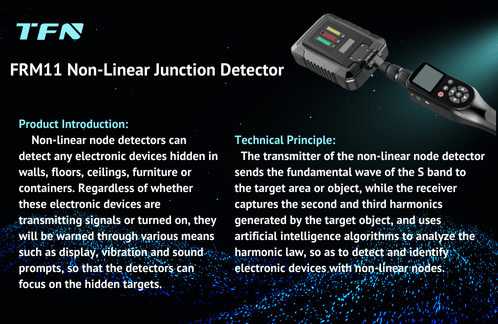TFN FM11D Nonlinear Node Detector Function Detailed Explanation
Non-linear junction detector is an advanced electronic device detection tool. It transmits the fundamental wave of a specific frequency band and receives the harmonics generated by the target object, and uses intelligent algorithms to analyze the harmonic law, so as to accurately detect hidden electronic devices. TFN FM11D non-linear node detector has a variety of practical functions and plays an important role in commercial security, public safety, and personal privacy protection. The following will expand its main functions:
1. Hidden electronic device detection function
FM11D nonlinear node detector can penetrate obstacles such as walls, floors, ceiling lamps, furniture or containers, and detect any electronic devices hidden in these areas. This function mainly relies on its advanced nonlinear node detection technology. In terms of detection distance, it can reach 400-500mm for GPS modules, 180-220mm for mobile phones, and 90-120mm for SIM cards.
2. No signal/no power-on detection function
Unlike traditional electronic device detectors, FM11D can detect electronic devices when they are not transmitting signals or are not powered on. This function is mainly due to its unique harmonic analysis technology, which can accurately identify the weak harmonic signals of the target device even when it is not working, thereby achieving effective detection of hidden electronic devices.
3. High-precision positioning and alarm function
When an electronic device is detected, the FM11D nonlinear node detector can provide accurate positioning information to the detector through display, vibration and sound prompts. The detector uses 2400MHz radio frequency detection technology to achieve high-precision positioning, helping the detector to quickly lock the location of the target device. At the same time, the detector's alarm function can also effectively remind the detector to pay attention to potential safety risks and ensure the smooth execution of the detection task.
4. Harmonic analysis and identification function
The FM11D nonlinear node detector has powerful harmonic analysis and identification capabilities. By receiving the second and third harmonics generated by the target object and using artificial intelligence algorithms to conduct in-depth analysis of the harmonic laws, the detector can accurately identify electronic devices with nonlinear nodes. This function not only improves the accuracy and reliability of detection, but also can effectively distinguish different types of electronic devices, providing strong support for subsequent processing.
5. Dynamic parameter adjustment function
FM11D nonlinear node detector can support dynamic adjustment of multiple parameters, including pulse mode transmission power (maximum 0-4W adjustable), receiving sensitivity (≤-140dbm) and receiving dynamic adjustable range (30db), etc. Detection personnel can flexibly adjust parameters according to actual detection needs and scenarios to achieve excellent detection results.
6. Data recording and storage function
FM11D non-linear node detector also has data recording and storage function. It can record the data information of each detection in detail, including the detection time, location, type and number of electronic devices detected, etc. These data provide an important basis for subsequent analysis and decision-making, and help improve detection efficiency and accuracy.
These functions enable it to handle the detection needs of electronic devices in different fields and scenarios.
TFN FM11D non-linear node detector has completely independent intellectual property rights, so its design and production are not subject to technology import restrictions from other countries, thus ensuring higher safety.

If you are interested in TFN FM11D non-linear node detector, please contact TFN sales team:
Email: info@tfngj.com
WhatsApp: +86-18765219251
Facebook: https://www.facebook.com/tfnfate/
